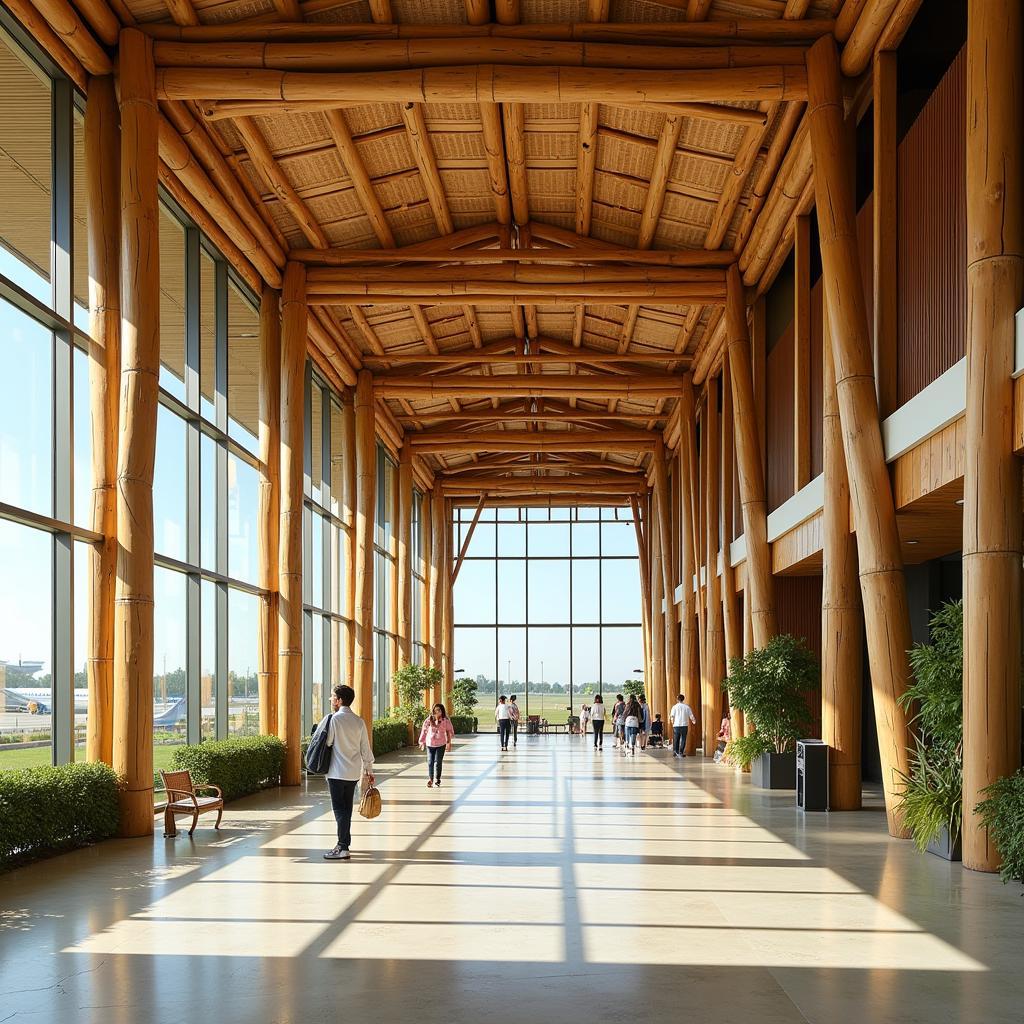Bamboo, a fast-growing, sustainable resource, has found its way into various industries, from construction to textiles. But could it also revolutionize the aviation sector? The concept of a “Bamboo Airport” sparks intrigue and raises questions about the feasibility and potential benefits of incorporating this versatile material into airport infrastructure.
While a fully constructed bamboo airport might still be a vision of the future, the potential applications of bamboo within existing airports are numerous and exciting. From interior design and furniture to structural components in terminals, bamboo offers a sustainable alternative to traditional materials. Imagine walking through an airport terminal adorned with sleek bamboo ceilings, relaxing on bamboo benches, and even witnessing bamboo being used in load-bearing structures.
The Sustainable Appeal of Bamboo in Airport Construction
One of the most compelling reasons to consider bamboo in airport design is its sustainability. Bamboo is a rapidly renewable resource, growing much faster than hardwood trees, making it an environmentally friendly choice. Its strength and flexibility also make it a viable option for various construction applications. Using bamboo can significantly reduce the carbon footprint of airport infrastructure and contribute to a greener future for air travel. This aligns perfectly with the growing global emphasis on sustainable development and reducing the environmental impact of aviation.
Imagine a future where airports are not just hubs of transportation but also examples of sustainable design, showcasing the innovative use of renewable resources like bamboo. Such airports could serve as models for other infrastructure projects, inspiring a wider adoption of eco-friendly building materials and practices. For instance, imagine the positive environmental impact of replacing traditional materials like steel and concrete with bamboo in airport terminals.
 Bamboo Airport Terminal Design Concept
Bamboo Airport Terminal Design Concept
Addressing the Challenges of Bamboo Construction
Despite its potential, several challenges need to be addressed before bamboo becomes a mainstream building material for airports. One key concern is durability and resistance to pests and weather. While bamboo is naturally strong, it requires proper treatment and preservation to withstand the rigors of airport environments. Research and development are crucial to overcoming these challenges and ensuring the longevity of bamboo structures. Another challenge is the standardization of bamboo as a building material. Developing consistent quality control measures and building codes is essential for widespread adoption.
Similar to hanoi airport, airports worldwide constantly seek ways to improve their infrastructure while minimizing environmental impact. Bamboo presents a promising avenue for achieving both goals.
Bamboo in Airport Interiors: A Touch of Nature
Beyond structural applications, bamboo can also enhance the aesthetic appeal of airport interiors. From flooring and wall panels to furniture and decorative elements, bamboo can create a warm, inviting, and naturally elegant atmosphere. Imagine relaxing in a bamboo-furnished lounge area before your flight, surrounded by the calming presence of nature. This incorporation of natural elements can contribute to a more pleasant and relaxing travel experience for passengers.
Bamboo’s versatility allows for a wide range of design possibilities, from traditional to modern, adding a unique touch to each airport’s character. The use of bamboo furniture and decorative elements can also promote local craftsmanship and create economic opportunities for communities involved in bamboo cultivation and processing.
 Bamboo Furniture in Airport Lounge
Bamboo Furniture in Airport Lounge
Is a Fully Bamboo Airport a Realistic Possibility?
While a fully bamboo airport might seem like a distant dream, the increasing focus on sustainability and the ongoing advancements in bamboo construction techniques suggest that it may become a reality in the future. Research and development continue to push the boundaries of what’s possible with this versatile material, opening up new possibilities for its application in large-scale infrastructure projects. As technology evolves and construction methods improve, the prospect of a bamboo airport becomes increasingly viable. This aligns with the aviation industry’s ongoing efforts to reduce its carbon footprint and embrace sustainable practices.
Just like exploring the options at guwahati airport shops, considering bamboo as a building material is a step towards a more sustainable and eco-conscious future for airports.
Bamboo Airports: A Vision for the Future
The concept of a bamboo airport represents a shift towards more sustainable and innovative airport design. While challenges remain, the potential benefits of incorporating bamboo into airport infrastructure are significant. From reducing the environmental impact of construction to creating aesthetically pleasing and welcoming spaces, bamboo offers a promising path towards a greener and more sustainable future for air travel. As we continue to explore the possibilities of this versatile material, the vision of a bamboo airport may one day become a reality.
The future of airport design might be closer than we think, with innovative materials like bamboo paving the way for a more sustainable and eco-friendly air travel experience. Similar to the modern design of kyoto airport, incorporating bamboo into airport architecture could be a defining feature of future airports.
In conclusion, while the concept of a “bamboo airport” is still evolving, the use of bamboo in airport construction and design holds immense potential for creating more sustainable and aesthetically pleasing environments. As research and development continue to advance, we can expect to see even more innovative applications of bamboo in the aviation industry.
Similar to noi bai international airport and other modern airports, adopting sustainable materials like bamboo is a step towards a greener future for air travel.
FAQ
- What are the benefits of using bamboo in airport construction? Bamboo is a sustainable, rapidly renewable resource that offers strength and flexibility, making it a viable alternative to traditional building materials.
- What are the challenges of using bamboo in airport construction? Durability, pest resistance, weatherproofing, and standardization are key challenges that need to be addressed.
- How can bamboo be used in airport interiors? Bamboo can be used for flooring, wall panels, furniture, and decorative elements, creating a warm and inviting atmosphere.
- Is a fully bamboo airport possible? While still a future concept, ongoing research and development suggest that a fully bamboo airport may be possible one day.
- Why is sustainability important in airport design? Sustainable airport design helps reduce the environmental impact of aviation and promotes responsible resource management.
- What are the long-term benefits of using bamboo in airports? Reduced carbon footprint, lower environmental impact, and aesthetically pleasing spaces are some long-term benefits.
- How can bamboo contribute to a more pleasant travel experience? The use of bamboo in airport interiors can create a calming and natural atmosphere, enhancing passenger comfort and well-being.
For any assistance or further inquiries, please contact us: Phone: +13089626264, Email: [email protected], or visit our office at 404 Bothwell St, Oxford, NE 68967, USA. We offer 24/7 customer support.

